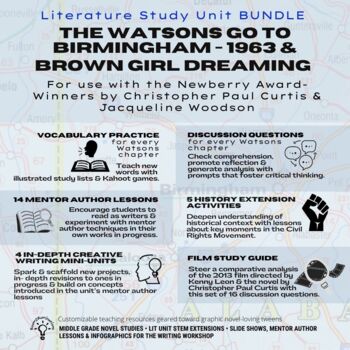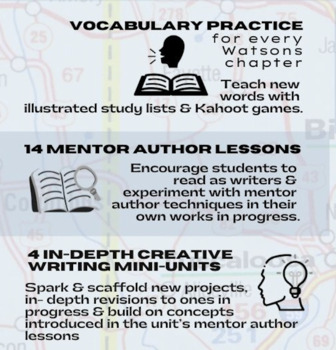The Watsons Go to Birmingham & Brown Girl Dreaming: A Lit Study Unit BUNDLE
- PDF
- Google Apps™

Description
This editable, Common Core-aligned resource pairs Curtis' historical fiction with Woodson's poetry in a close look at themes these two middle grade books share. Lessons included span the curriculum. Find activities for developing literacy, building vocabulary, teaching literary analysis, creative writing & argument building. Everything you need for an in-depth study.
This is a google doc. After purchase you will download a PDF with a link to the resource. Copy & edit as you wish.
The unit's focus is on The Watsons, with periodic dips into selected poems from Brown Girl Dreaming that explore similar themes or writing strategies.
Prompts appear in order of complexity, and simplified language appears in parentheses (delete or modify as needed).
Against the backdrop of the Civil Rights Movement, The Watsons chronicles the sometimes violent, sometimes tender relationship between ten-year-old Kenny Watson and his older brother, Byron, an “official juvenile delinquent.” When Byron eventually steps over the line one time too many, Momma and Dad finally make good on their threat to send him to stay with his strict grandma in Alabama, in hopes that a summer in the deep south will open his eyes to “the kind of place the world can be.” Soon after the family arrives, they find themselves at the center of one of the most tragic moments in America's history: the Sixteenth Avenue Baptist Church bombing.
Woodson’s Brown Girl Dreaming covers similar geographic and thematic terrain so I teach the works together, interspersing chapters of the novel with poems from Woodson’s collection. Both works are Newberry winners that feature young African-American protagonists growing up in a nation on the brink of sweeping change. The sacrifices Birmingham’s Black citizens made in the summer of 1963 were pivotal to the passage of the Civil Rights Act the following year, and while Curtis’s work is fiction, it draws on his childhood experience coming of age during this especially tumultuous chapter of American history. Born in Ohio to a family of African-Americans who fled the agrarian south for more opportunities in northern cities, Woodson, like the fictional Watsons, is a product of the Great Migration. Her poetry—like Curtis’s fiction—echoes her childhood experience. Beginning with Woodson’s birth in 1963, Brown Girl Dreaming picks up history where The Watsons leaves off.
Unit Components & Features
LITERATURE RESPONSE QUESTIONS
A set of prompts for each chapter of The Watsons, grouped for differentiated instruction. Since this unit is editable, you can choose the prompts that best fit your needs and/or break the class into groups and assign different prompts to each group.
NOTE: The lit responses do not include answer keys. Though some questions here are designed to assess comprehension, the overall objective is to promote discussion, critical inquiry and the development of argument-building skills. Most prompts here are open-ended so a variety of responses will be "correct," depending on how well-supported they are.
TECH CONNECTIONSVocabulary-building on KAHOOTPractice games for this unit’s
vocabulary words are available to play on Kahoot, a free online platform where students compete game show-style. Find links to Kahoot games in the Vocabulary section of each literature response.
✎ SHORT MENTOR TEXT EXERCISES
Designed to integrate into a writing workshop and built around a specific writing strategy, each mentor text exercise asks students to read as writers—to pay close attention to elements of craft—and apply the mentor author’s writing techniques to their own works in progress. Passages from The Watsons and/or Brown Girl Dreaming serve as springboards for these exercises which also include:
- Graphic organizers and sentence-frames.
- Slideshows and/or explainer videos.
- Links to student writing samples that model approaches to applying the mentor author techniques under consideration.
IN-DEPTH MENTOR TEXT MINI-UNITS & POETRY EXTENSION PROJECTS
- The Watsons/Brown Girl Dreaming Mentor Text Mini-unit • Like Life: Borrowing from History & Headlines, Family & Friends
- Brown Girl Dreaming Mentor Text Mini-unit: A Day, a Life, a World
- Poetry Extension: Growing Metaphors with “Seeds” & “Branches”
- Poetry Extension: The Texture of Vengeance, the Flavor of Fury
Designed to spark and scaffold new creative writing projects, in-depth revisions to ones in progress and/or build on concepts introduced in this unit’s mentor text exercises, each mini-unit is a detailed, 1-2 week lesson plan that includes:
- Introductions to each day’s reading, discussion, and/or writing session.
- Excerpts of the mentor texts under consideration.
- Links to student examples that model the approaches under consideration.
- Questions to guide discussions.
- Prompts, graphic organizers, and word banks to get students started.
- A series of editable Revision Workshop hyperdocs to guide students through the revision process.
HISTORY EXTENSION ACTIVITIES
- The Child Nutrition Act of 1966
- Ain’t Ain’t a Word? The History of AAVE
- That Stuff on TV: The Birmingham Children's March CLICK TO PREVIEW
- The Green Book
- The Birmingham Church Bombing of 1963
These activities include links to podcasts, websites, and videos designed to scaffold an exploration of the novel’s themes and historical context.
THE WATSONS FILM RESPONSE QUESTIONS CLICK TO PREVIEW
The novel’s 2013 film adaptation, The Watsons Go to Birmingham (sans the 1963), drops quite a bit of character development in favor of a much more detailed—if, at times, forced—exploration of historical context. Nonetheless, the film is still a valuable teaching tool. While the Civil Rights struggle forms a subtle backdrop to events in the novel, the film puts the movement’s Birmingham Campaign in the spotlight -- along with the police violence that came with it -- laying bare themes the novel only hints at, namely racism and the difficult choices people must make in the face of injustice.
Like the Literature Response prompts, the Film Response questions are grouped for differentiated instruction into Comprehending, Analyzing, and Connecting sections. The Comprehending questions focus on identifying elements of the film that differ from the novel. The Analyzing questions are geared toward a comparative analysis of the two works and the Connecting prompts ask students to explore themes and questions unique to the film version of the story.
EDITABLE CONTENT & FLEXIBLE FORMATTING
This unit is a Google document, so you can easily modify anything here to fit your own needs. If you are new to Google docs, check the quick tips for navigating and editing this unit here. NOTE: This unit includes many links to other documents. To edit those, make your own copy first then edit your copy. If you want students to click your edited version, make sure to replace the old link with your new one in the doc students will access.
Follow me for product updates & freebies.
Middle-grade writing workshop tips and tales from the trenches




